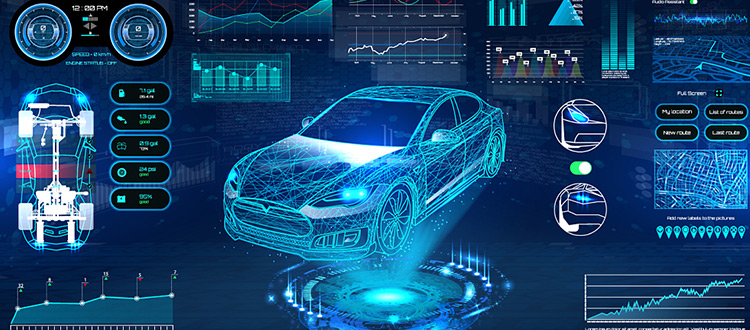The electronicization of automobiles is regarded as a revolution in the development of automobile technology. The degree of automotive electronics is regarded as an important indicator to measure the level of modern automobiles, and is the most important technical measure used to develop new models and improve automobile performance. Auto manufacturers believe that increasing the number of automotive electronic equipment and promoting automotive electronics are important and effective means to seize the future automotive market.
According to statistics, from 1989 to 2000, the average proportion of electronic devices on each car in the overall car manufacturing cost increased from 16% to more than 23%. In some luxury cars, the number of single-chip microcomputers has reached 48, and electronic products account for more than 50% of the cost of the entire vehicle.

According to the impact on the driving performance of automobiles, automobile electronic products can be classified into two categories: one is automobile electronic control devices. The automobile electronic control devices must be used in conjunction with the on-board mechanical system, which is the so-called "electromechanical integration" of automobiles. Electronic devices; they include engine, chassis, and body electronic controls. For example, electronic fuel injection system, anti-lock brake control, anti-skid control, traction control, electronically controlled suspension, electronically controlled automatic transmission, electronic power steering, etc. The other category is in-vehicle electronic devices. An electronic device that can be used independently in the environment has no direct relationship with the performance of the car itself. They include car information systems (driving computers), navigation systems, car audio and TV entertainment systems, in-vehicle communication systems, Internet devices, etc.
In 2008, the direction of electronic technology development was towards centralized integrated control: integrating the engine management system and automatic transmission control system into the integrated control (PCM) of the power transmission system; integrating the anti-lock brake control system (ABS) and traction control The system (TCS) and the drive anti-skid control system (ASR) are integrated to perform brake control; through the central chassis controller, the control systems such as braking, suspension, steering, and power transmission are connected through a bus. The controller coordinates the various subsystems through complex control calculations to control the vehicle's driving performance to the best level, forming an integrated chassis control system (UCC).
Due to the rapid increase in the number of electronic and electrical devices in automobiles, in order to reduce the number and weight of connecting wires, network and bus technologies have developed greatly during this period. Bus technology is to connect various automotive electronic devices into a network, and send and receive information through a data bus. In addition to independently completing their own control functions, electronic devices can also provide data services for other control devices. Due to the use of a networked design, the wiring is simplified, the number of electrical nodes and the amount of wires are reduced, the assembly work is simplified, and the reliability of information transmission is also increased. Any electronic control device can be accessed through the data bus, and the fault code can be read for fault diagnosis, which makes the maintenance of the whole vehicle easier.
The application of automotive electronics technology will cause the following major changes in cars:
1. The mechanical structure of automobiles will undergo major changes, and the various control systems of automobiles will develop toward electronic and electrification, realizing "wire control". Replace the original mechanical transmission mechanism with wires, such as "wire brake", "wire steering", "electronic throttle" and so on.
2. Car 12-volt power supply system is converted to 42-volt. With more and more electronic devices in automobiles, the power consumption is increasing substantially. The existing 12-volt power supply can no longer meet the needs of all electrical systems in automobiles. In the future, an integrated starter-generator 42 volt power supply system will be adopted. The maximum output power of the generator will be increased from 1 kilowatt in 2005 to about 8 kilowatts, and the power generation efficiency will reach over 80%. The implementation of the new 42-volt automotive electrical system standard will cause major changes in the design and structure of automotive electrical components, and mechanical relays and fuse-type protection circuits will be eliminated.
The application of automotive electronics technology will make cars more intelligent. Smart cars are equipped with a variety of sensors, which can fully sense the conditions of drivers and passengers, traffic facilities and surrounding environment information, determine whether the occupants are in the best condition, whether the vehicle and people will be in danger, and take corresponding measures in time.
Today, the society has entered the age of information network. People hope that the car is not only a means of transportation, but also an extension of the scope of life and work. In the car, it is like staying in your own office and home, and you can listen to it. Broadcasting, making phone calls, going to the Internet, handling work. With the advancement of digital technology, automobiles will also enter the multimedia era. The on-board computer multimedia system developed by the operating system has the functions of information processing, communication, navigation, anti-theft, language recognition, image display and entertainment. For the foreseeable future, the car will be equipped with automatic navigation and assisted driving systems. The driver can input the destination of the car into the car computer, and the car will follow the best driving route to reach the destination. People can use the language recognition system to control various facilities in the car, while driving the car, while watching music and TV, and can also book dinner tables and air tickets online.







